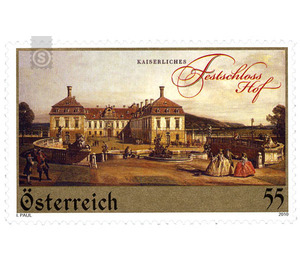Attractions - Austria / II. Republic of Austria 2010 - 55 Euro Cent
Theme: Architecture
| Country | Austria / II. Republic of Austria |
| Issue Date | 2010 |
| Face Value | 55.00 |
| Edition Issued | 900,000 |
| Printing Type | offset |
| Stamp Type | Commemorative |
| Item Type | Stamp |
| Chronological Issue Number | 2202 |
| Chronological Chapter | OOS-OE2 |
| SID | 754237 |
| In 56 Wishlists | |
Less than an hour's drive from Vienna, on a property of more than 50 hectares, a unique princely ensemble of magnificent architecture and masterfully designed nature stretches out. As a baroque Gesamtkunstwerk, the imperial Festschloss Hof opens an interesting gateway to the splendid magic of the once imperial life - in the footsteps of Prince Eugene and Maria Theresia you immerse yourself in a fascinating past time. History: Not least in its glorious residences found power and wealth of the already legendary during his lifetime commander Prince Eugene of Savoy. His Viennese Winterpalais in Himmelpfortgasse (today's Ministry of Finance) and the Belvedere in the imperial residence city of Vienna are undoubtedly among the most outstanding achievements of Austrian baroque architecture - whose creator, Lucas von Hildebrandt, also realized the prince's last major construction project: in the years of 1725 Schloss Hof was built as a solid retreat, a luxurious hunting lodge and an authentic setting for elegant courtly celebrations until 1729. Splendor and grace of the magnificent ensemble of castle, terraced garden and spacious manor impressed Empress Maria Theresa so much that she acquired the castle in 1755 by Prince Eugens heirs. In order to create even more space for her guests as well as for her large-headed household, she had the building supplemented by one floor, giving it its current appearance. With the era of Maria Theresa, however, the heyday of Schloss Hof gradually came to an end. Their successors showed little interest in the stylish summer residence - and towards the end of the 19th century, 1898, the imperial splendor was completely extinguished when Emperor Franz Joseph gave the castle of his army as a training center. Before the soldiers and their horses lodged here, all the furniture was brought to the imperial depots. At that time, 200 cars, full of furniture and valuable works of art, rolled from Marchfeld to Vienna. In the spring of 2002, the revitalization of the castle began one of the most ambitious cultural projects in the recent history of Austria. With the help of historical plans, inventories and paintings the original splendor could be restored as far as possible. After an elaborate restoration, today's exquisite furniture and paintings once again decorate those rooms for which they were once created by the most famous artists and most renowned manufactories of the Baroque period. The motif of the special stamp shows a painting by the Venetian painter Bernardo Bellotto, called Canaletto (1722-1780), who is known for his realistic views of European cities.


